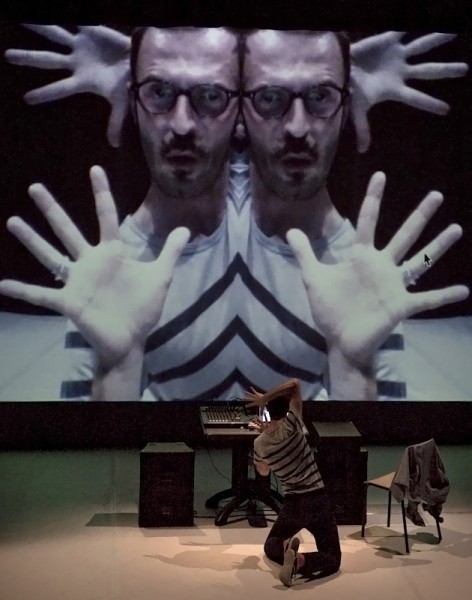Tuesday evening at The Place saw dance artists indulge in their craft, sharing and nurturing their wealth of ideas in the form of ‘Currency’. This season aims for a common currency to be shared through experience, bridging cultures and crossing borders. Little needed to be added to the scrumptious feast served up in the basement; dance enthusiasts relished the chance to converse in all things dance over a plate of delicious falafels, hummus and salad. However this currency had yet to fully convert its followers. In the hours that followed, they happily meandered from floor to floor savouring the rich ideas of Frauke Requardt (Germany/UK) and Alessandro Sciarroni (Italy), Alma Söderberg (Sweden) and Tabea Martin (Switzerland).
Requardt and Sciarroni were given two days to explore, exchange and envelope their ideas. Their fluid exchange is delivered in an intimate sharing at the Founders’ Studio. Coined a ‘blind date’, this collaboration uses an economy of movement to highlight immense difference. Requardt scans the room with curiosity bringing intense awareness to her fingers’ gentle movements. She strokes her expansive, pregnant belly. Sciaronni joins in with his comparatively flat and hairy torso. We are invited to make comparisons with their bodies, their voices and their movement aesthetics. They carefully package their engagement, silently dressing and undressing, slapping and smirking, shaking and holding. The beauty of difference is unwrapped and laid bare.
Ryan Djojokarso and Stefan Baier question difference and homogeny in Tabea Martin’s ‘Duet for Two Dancers’. ‘I am a dancer and I dance like this’…’I dance exactly the same.’ Erotic, beautiful, wow, still, decisive, impossible and unexpected movements are executed with glittery nudity. The microphone perspires as some serious questions about identity are brought into the spotlight. ‘Since I became a dancer, I sometimes wonder if I chose the right profession.’ Baier has every right to wonder; his breath fails him as he delivers his lines, his arms quiver as they hold his partner above his head and his legs buckle as he comes down to the short mike. These performers fight tooth and nail to discover what their identity means ‘I doubt if this dance makes any difference at all’. Their labour results in sweat dripping from every pore. Exhausted, the men call for musical movements, throwing in the towel to the sound of Igor Stravinsky.
Music drives ‘Travail’, a rigorous solo by Söderberg. Her working tools include sound, movement and language; she shakes, stamps and sings ‘uncensored’. Her serious interest in sound sizzles through the space from the onset. Intense rhythms are thrown out from her hand held shakers. She punctures her ankle bells with beat box vigour. Her range of tones are phenomenal and it is a treat to see her move through the space to the sound of her homemade DJ set. Meanwhile, a coil of copper sits and asks to be seen in silence. We will Söderberg on through her exchange, and she seems extremely grateful for our support.
What is important about this currency is the manner in which it is shared pre, mid and post performance. ‘Come on in, take a seat,’ says Söderberg to a latecomer, happily resting from the opening moments of her ‘Travail’. Martin, with her little infant wrapped in a sling, silently encourages and smiles at her dancers as they invest in her acclaimed duet; ‘This is how I choreograph’, she says, leaving the stage with a trusting glance at her performers. Reqardt and Sciarroni are content to be engulfed by intrigued spectators following their interchange of movement ideas. ‘Why did you hit her?’, says a concerned viewer addressing Sciarroni, a small boney structure who slaps his date repeatedly on the arm. ‘Because I like a bit of violence’, Requardt interjects humorously, laughing with her bemused audience.
The value of the Currency season at The Place cannot be underestimated. I experienced fluid international exchanges in which shining gems came to the surface, bringing light to this precious art form. The ‘International Exchange of Danced Ideas’ flourished and enriched The Place over a mere four hours. The possibilities for this to grow are endless.

